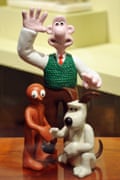Peter Lord, animator

The BBC was looking for some short animations for a programme called Vision On. They had to be entirely visual, because the show was aimed at deaf children. David Sproxton and I had done some hand-drawn work, but it wasn’t terribly good. So, inspired by an American [architect and designer] called Eliot Noyes, we thought we’d try models instead, and came up with these creatures we called Gleebies: little figures made from clay in primary colours. When the BBC asked if we’d do something similar for Take Hart, an art show hosted by Vision On presenter Tony Hart, it seemed logical to develop the idea. One day I picked up a ball of plasticine. There Morph was.
It was so obvious: plasticine is such a malleable material, so we could shape and reshape him. Plus, because he’s only one colour, that lovely warm brown terracotta, Morph was easy to work with – no worries about reflections, or whether the camera would pick it up.
Everything was done with simplicity in mind. We shot on 16mm film, one frame at a time, with no way of seeing what we had until the film came back from the lab a few days later. That made it a bit like flying in the dark. I’d sit at the table with Morph, the camera at my shoulder, lean forward and move him, then lean back and take a shot. It took about a week to make one minute of film, but that’s actually fast compared with how long it takes today.
Looking at the first animations we made, he looks rather primitive: Neanderthal Morph, some brutish ancestor of the sleek modern Morph, with heavy feet. But he was always very expressive: you could do so much simply by changing the angle of his body. I think that’s why people love him – he’s so easy to relate to. Our great fear, though, was that he’d fall over. That could be catastrophic. If he fell over on to his nose, I’d have to find some way to patch him up exactly as he had been. The only thing that kept him upright was careful balancing and the slightly sticky texture of his feet. Whenever I nipped to the loo, I had to prop him up with lots of mugs.

David Sproxton, producer
The whole set-up was unbelievably basic. Morph was straight out of the box: plasticine body, simple black-and-white eyes – nothing else. If he had to fly, we used nylon fishing line stuck into his back and painted the same colour as the background. We’d then cross our fingers and hope it worked.
It’s difficult to say where a lot of the early plot ideas came from, partly because some of it was left to chance. But we’d develop a rough storyboard and get to work. A major influence was silent comedy – Charlie Chaplin, Harold Lloyd, Buster Keaton. Morph certainly had a Chaplin kind of mischief. You’d put him in a situation and he’d find a way of getting into trouble. But he always bounced back – literally.
We had no idea, when we were doing these tiny films for £25 a week, that Morph would still be here four decades on. And no one could have guessed that he’d help give birth to a studio like Aardman, which now employs almost 300 people. It was because of Morph’s success that Channel 4 invited us and Nick Park to make Creature Comforts, which helped bring about Wallace and Gromit and all the rest.
In a way, it’s fitting he has lasted this long. The great thing about Morph is that we simply reuse him: once we’ve finished, we’ll put the lump back in the box and save it for another day. He’s indestructible.

Comments (…)
Sign in or create your Guardian account to join the discussion